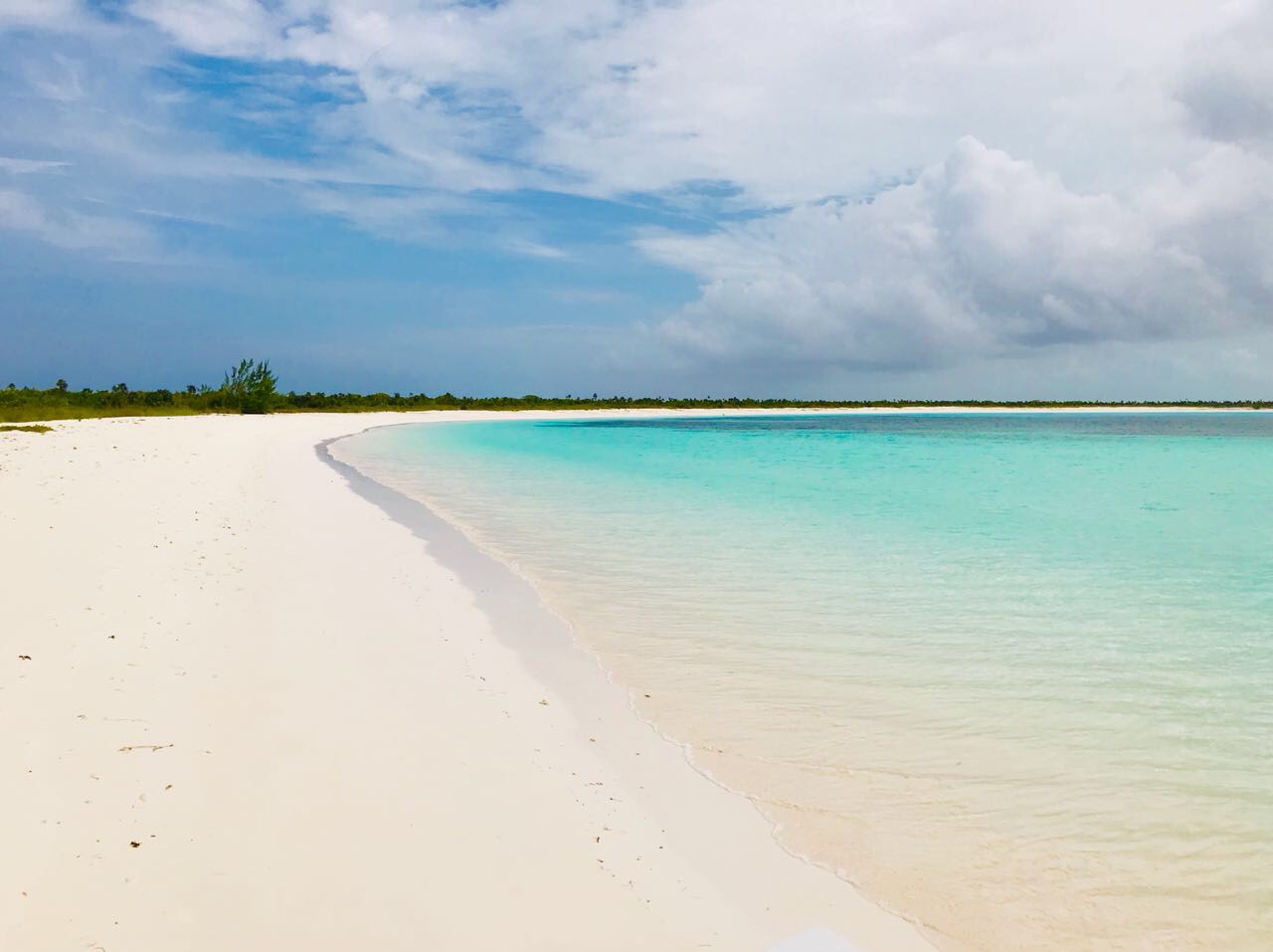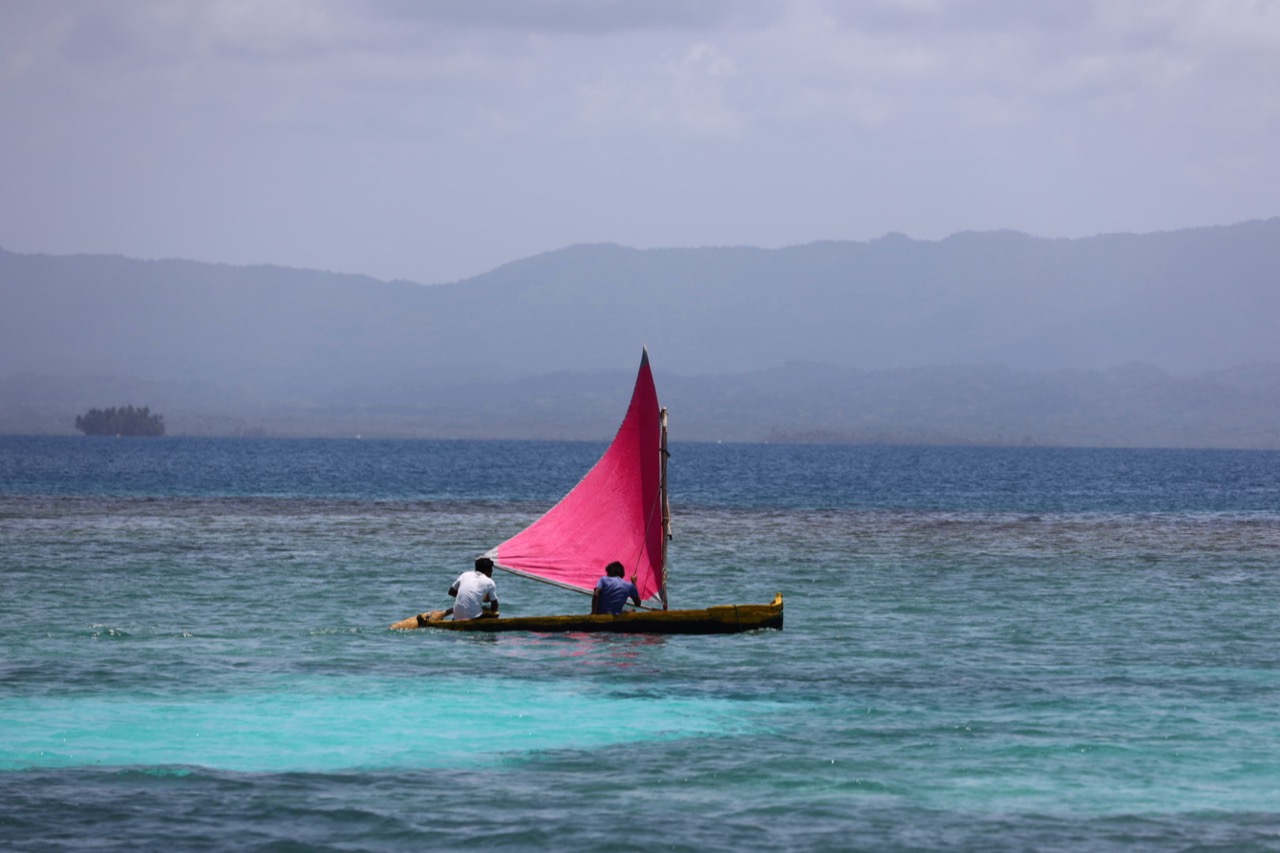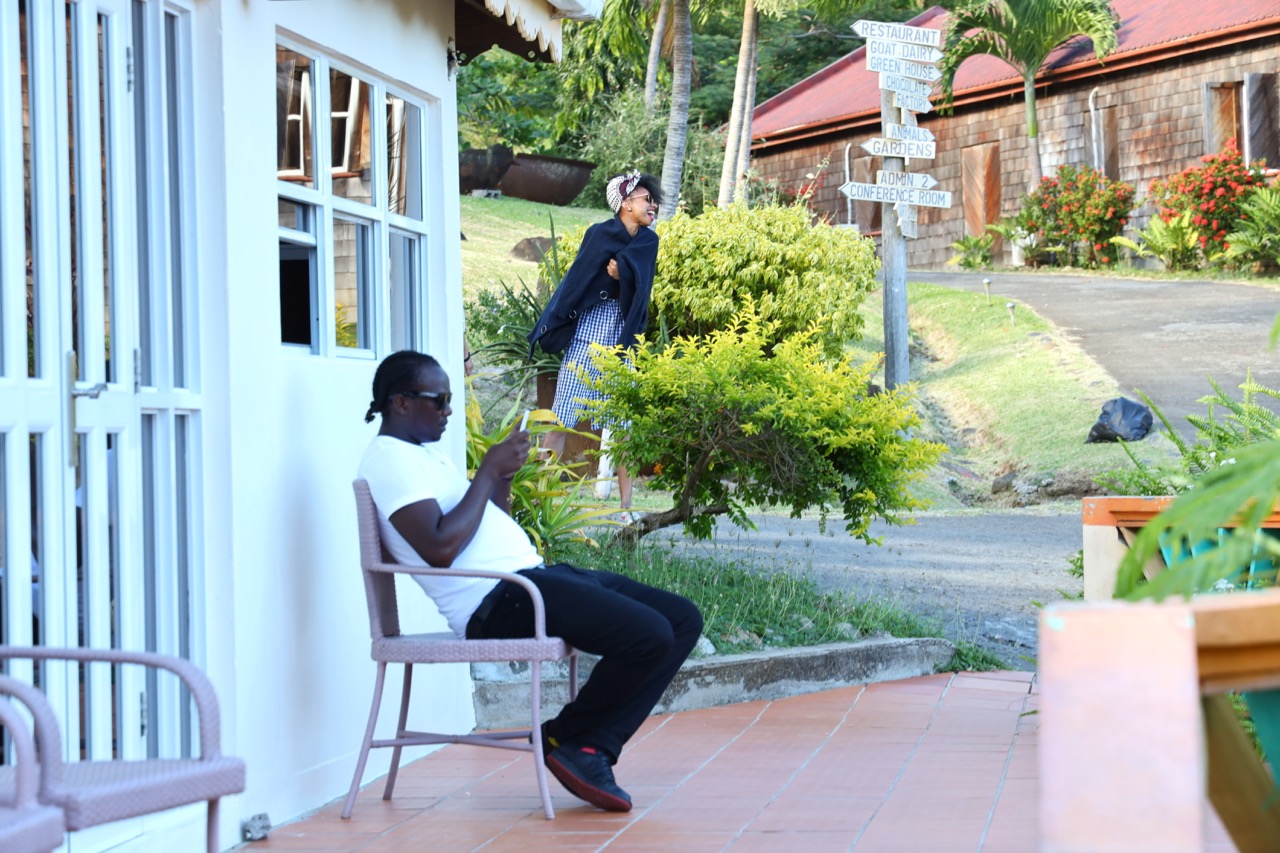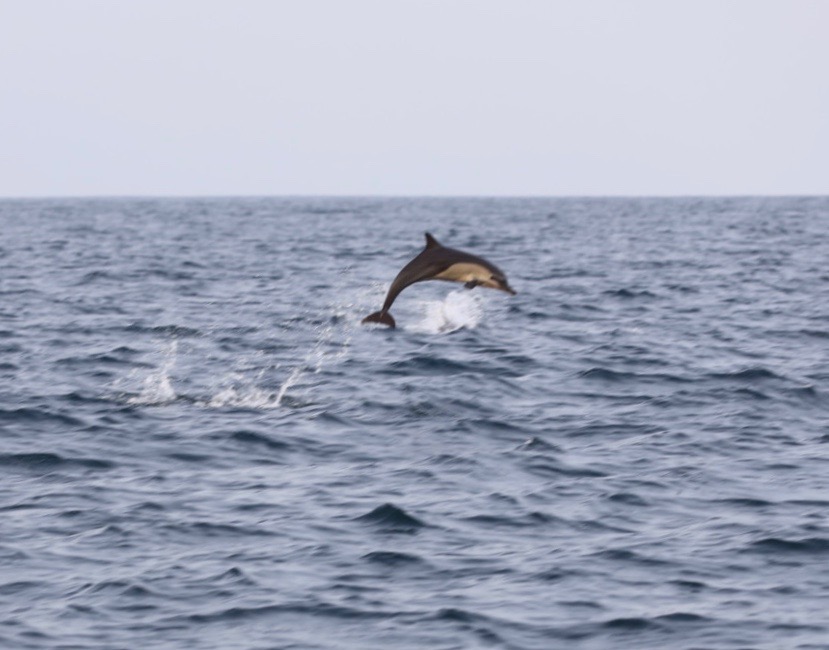 The watch has just changed and Marie has briefed me and gone to her bunk and I have taken over the night watch from 12-4 in the early hours. The breeze comes from SE and we are sailing with 6.5 knots towards SW – The Enchanted Islands, Galapagos. The night is tropical and magical. Stars above, fire in the water and a lonely moon trying to keep up, but slowly fading. A couple of miles out, I can see the comforting green light from Greyhounds top lantern – and that is about it. It is vast and deserted, except of course for the crazy wildlife under the calm sea floor. I hear the occasional noise from a flying fish arriving on the deck and I nod good evening to six red-footed boobies, sitting on the anchor in front of the boat; hitch hiking through the night. They are sound a sleep and once in a while, one of them looses balance and fly around the boat and take up there spot again, and sleep. I am truly blessed, that I get to experience nights like this.
The watch has just changed and Marie has briefed me and gone to her bunk and I have taken over the night watch from 12-4 in the early hours. The breeze comes from SE and we are sailing with 6.5 knots towards SW – The Enchanted Islands, Galapagos. The night is tropical and magical. Stars above, fire in the water and a lonely moon trying to keep up, but slowly fading. A couple of miles out, I can see the comforting green light from Greyhounds top lantern – and that is about it. It is vast and deserted, except of course for the crazy wildlife under the calm sea floor. I hear the occasional noise from a flying fish arriving on the deck and I nod good evening to six red-footed boobies, sitting on the anchor in front of the boat; hitch hiking through the night. They are sound a sleep and once in a while, one of them looses balance and fly around the boat and take up there spot again, and sleep. I am truly blessed, that I get to experience nights like this.
It is now the second night of the pleasant ones and North Star have excelled on an South easterly wind on her left shoulder for about 48 hours and she is enjoying every moment. Our first days were windless and when the wind arrived it was on the nose! It felt like Mother Nature had decided, that we were not allowed to visit these old islands, and they were still moving around as it was believed, when they were first discovered by a Bishop from Panama. Yes you are right he was just not a great navigator…They have actually been there for millions of years and the first islands, products of volcanos, have already disapeared under the surface. We are sailing on top of the Nazca Plate, a teutonic plate, creating a lot of noise in the areas. The latest was as late as 2009, right in the middle of Galapagos, where one of the volcanos erupted and that is also how the 30 Galapagos islands was created some millions of years ago.
Anyway, back to sailing. Our noon runs (miles sailed from noon to noon) have improved from 125 to the latest of 165, and this current run will be even longer, so we have started to look out for the islands, in spite of our 135 nm to go! It is going to be good to feel land again and have a cold beer, even though we had half a beer and steaks for dinner tonight in celebration of our equator crossing tomorrow morning, where King Neptun will visits us and see if we are worthy of passing into his kingdom.
Yes, even though nothing happens for hours or days, when you sail across an ocean, something happens all the time. And if nothing happens you make something happen – like nothing, for a while. And nothing or action in slow motion is something we are not too used to, living in our current world.
So there you have it and when we reach Galapagos we will upload pictures of our six red footed boobies and save our 100 usd for the tour going to see them in the wild. We have seen them for 24 hours right in front of us.
Year: 2019
A night on the Pacifico
A moonlit night on a vast ocean – it is beautiful and with no skies -just stars to show us the way. We are cruising with 6 knots and listen just to the speed of the boat hitting the waves – everything else in the world is quiet and crew sleeps in your bunk – and I am in the grove for much more sailing – finally. I do not know, why but the first three days seems to be an uphill battle every time. We have finally past the ITCZ and the doldrums, so at least for now the evening lightshow on the sky, which scares the s….out of me is over and no more engine or drifting for now – just pure exhilirating fats sailing. It does not get better than this and maybe the expectation of a cold beer when we finally arrive.
AS you will observe from our postion, we are closing in on our first passage of the equator and the are at least a couple of first timers on board. Accoring to the ritual the need to be baptized and make their peace with King Neptun, to secure the boat safe sailing, and we will certainly arrange accordingly.
Our position is 01 46.557 N and 085 33.478 W, cog is 221 finally south east and sog is 6.3 with much less counter current than in a long time. 289 nm to go – which is about two days – so we are soon making landfall, at these fantastic islands, we have all been reading about.
Looking forward to thread lightly in the footsteps of Darwin and see the turtles, which caused a revised view on our story of creation.
Life is good,
The start from Panama – Pacifico
The biggest ocean of them all, the most deserted, the ocean with some of the most desirable cruising grounds – The Pacific. And today it is living up to its name! It is vast and deserted and not many boats come here exactly because of that, I guees. That is why we are here to take on the challenge, see the spectaculars – together with our buddy boat Greyhound.
We have taken up the challenge and have just started to cross the 9000 nm towards New Zealand. We left this morning and the ocean is like a mirror and the engine is running at 1300 rpm, very quit in the background. We have 840 nm left to Galapagos and we hope to arrive on the 17th of April – but only if King Neptun will let us pass the equator!!
We have used the last weeks preparing the boat and boat supplies for our 3 months crossing to the next supermarket on Tahiti, where we underway will visit Galapagos, Marquesa, Tuamotus and finally Tahiti. From here the plan is to continue to New Zealand.
I still have a few updates from our trip from Grenada to the crossing of the Panama canal via Aruba and San Blas, but have not been successful uploading the pictures – so they will come later – for now it is the Pacific, without pictures as this post is uploaded vis sat connection.
This morning just after we came out of the bay of San Jose, the last of the Pearl islands, we heard the blowing sound of a whale, and a few second later about 50 meters behind us, we saw a big whale greeting us welcome into the Pacific. Shortly thereafter, we were followed by a large group of dolphins, who I am sure, will bring us luck on our journey. Kim, our crew for this leg, was happy and claims he now only need to see pingvins on Galapagos!
Unfortunately our luck did not last for long. At least late afternoon we noticed that our 24 v alternator did not charge the batteries and frankly out here, you want to be able to charge batteries. We decided to continue to Galapagos and will amke repairs there. Until then we will make due with generator and solar power as I was unable to fix it.
But except these trivials, we are settling into a quiet rhyme and in a couple of days, the days will just pass as we enjoy our slow ocean travel towards one of the most fantastic place on this globe.
Getting ready for the Pacific
It was a tremendous feeling of accomplishments to arrive into Shelter Bay in Panama after 780 nm and called first Christobal Control tower on vhf channel 12 and then Shelter Bay Marina at 14.

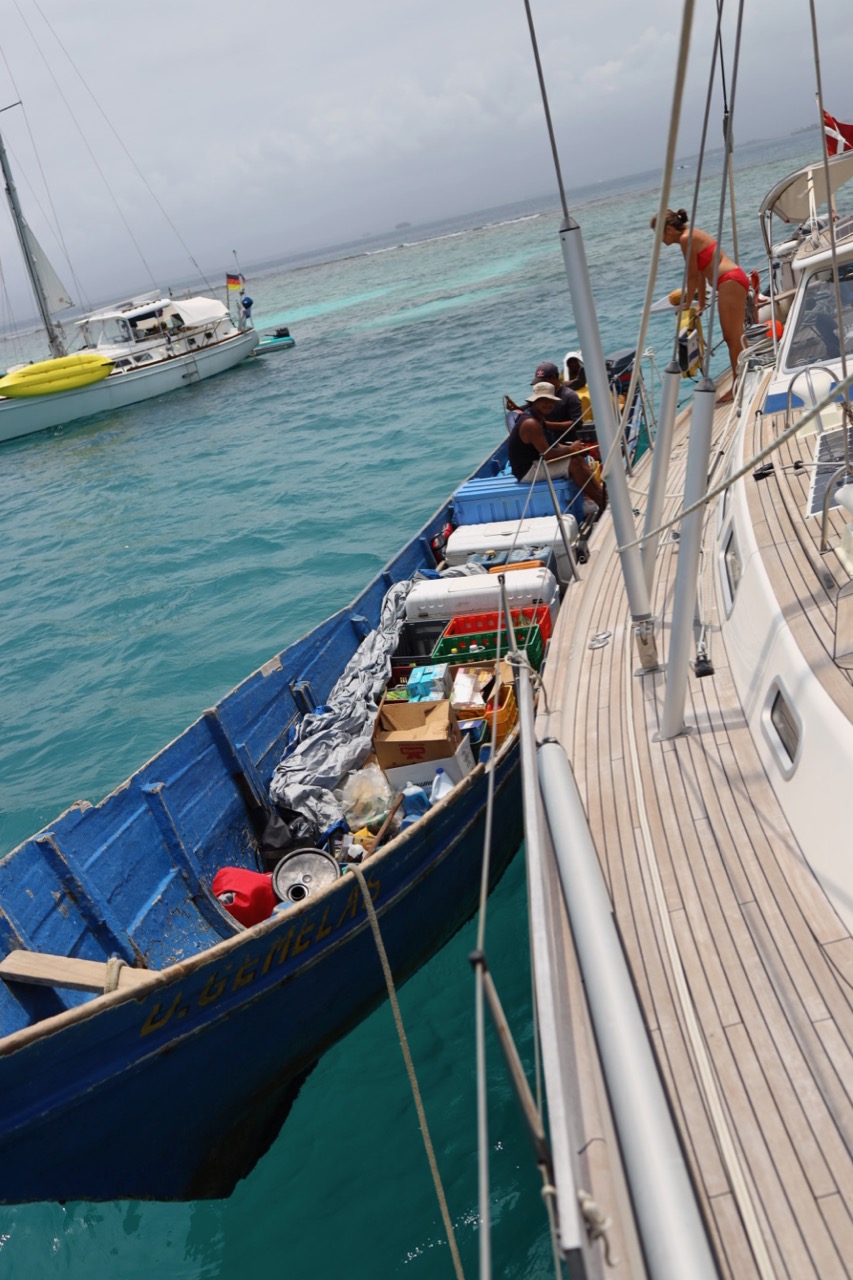




We had been talking, planing and dreaming about this, for so long.
We were awaited as we had reserved and received a very pleasant welcome. We did hire an agent Roy Bravo, who is also the agent of the World ARC fleet and did help us in so many ways. Can you do it yourself, yes some does but in South America a local representative is often very helpful to avoid the worse pitfalls. And Roy is good, he knows his stuff.
Shelter Bay is a kaleidoscope of sailors from around the world. All have sailed a long way to get here and all are good sailors, because else they would have given up long ago. There is a great restaurant, bar, swimmingpool and a twice a day bus to Colon for the provisioning for the long trip to Tahiti. So it is a nice place to make friends, get ready and relax for a week or two. Most hang out a while and most are waiting for crew and spareparts.
We welcomed a very good friend, who was going to sail to Galapagos with us, did our provisioning, relaxed and sailed back up to the Sant Blas island for a week, while we waited for our slot time to go through the Canal.
As you can see on the pictures from San Blas Islands, it is paradis – it is exactly what most people imagine before the visit the Caribbean for the first time.. We visited Cayos Chichime, Coco Banderas, and East Hollandaise and enjoyed the swimming, the sea turtles the lobsters and just being in Paradis with no communication to the outer world.

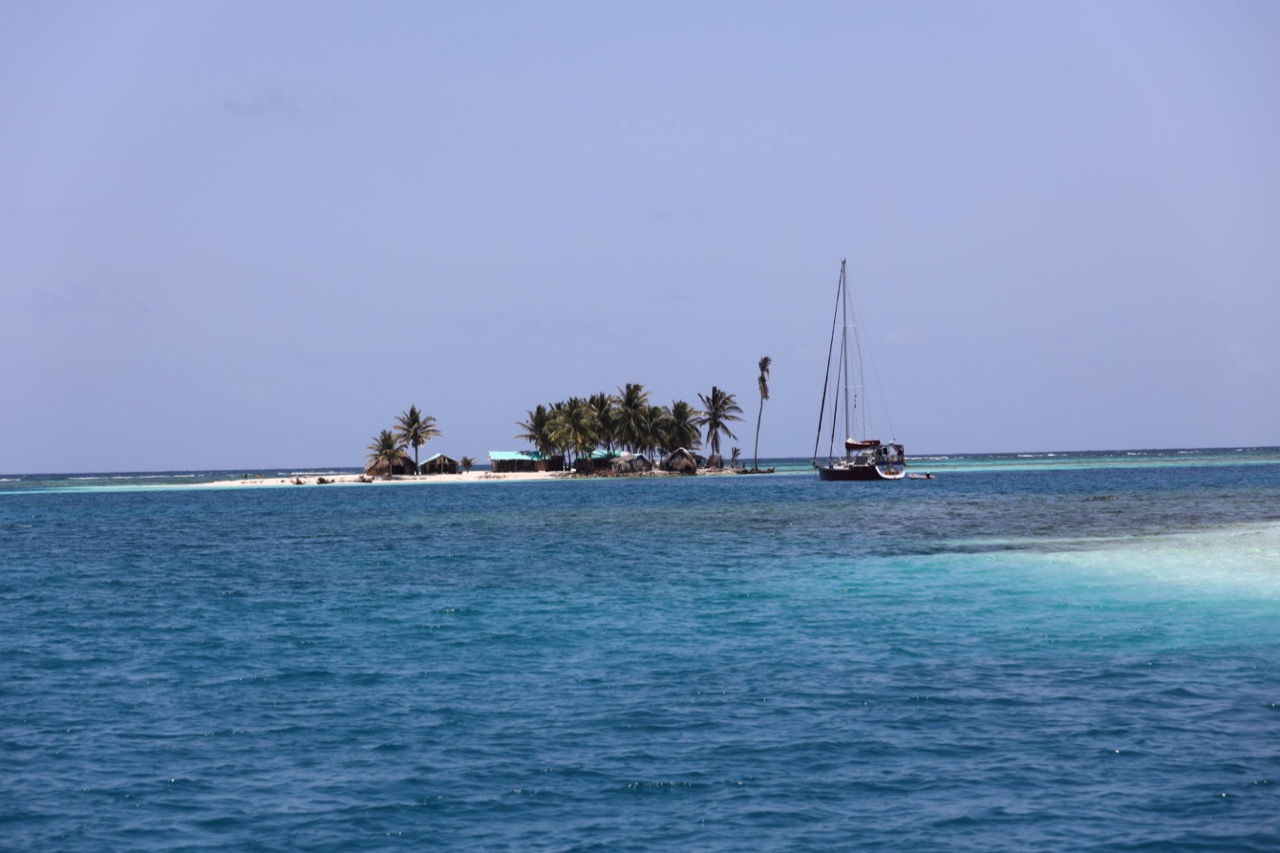
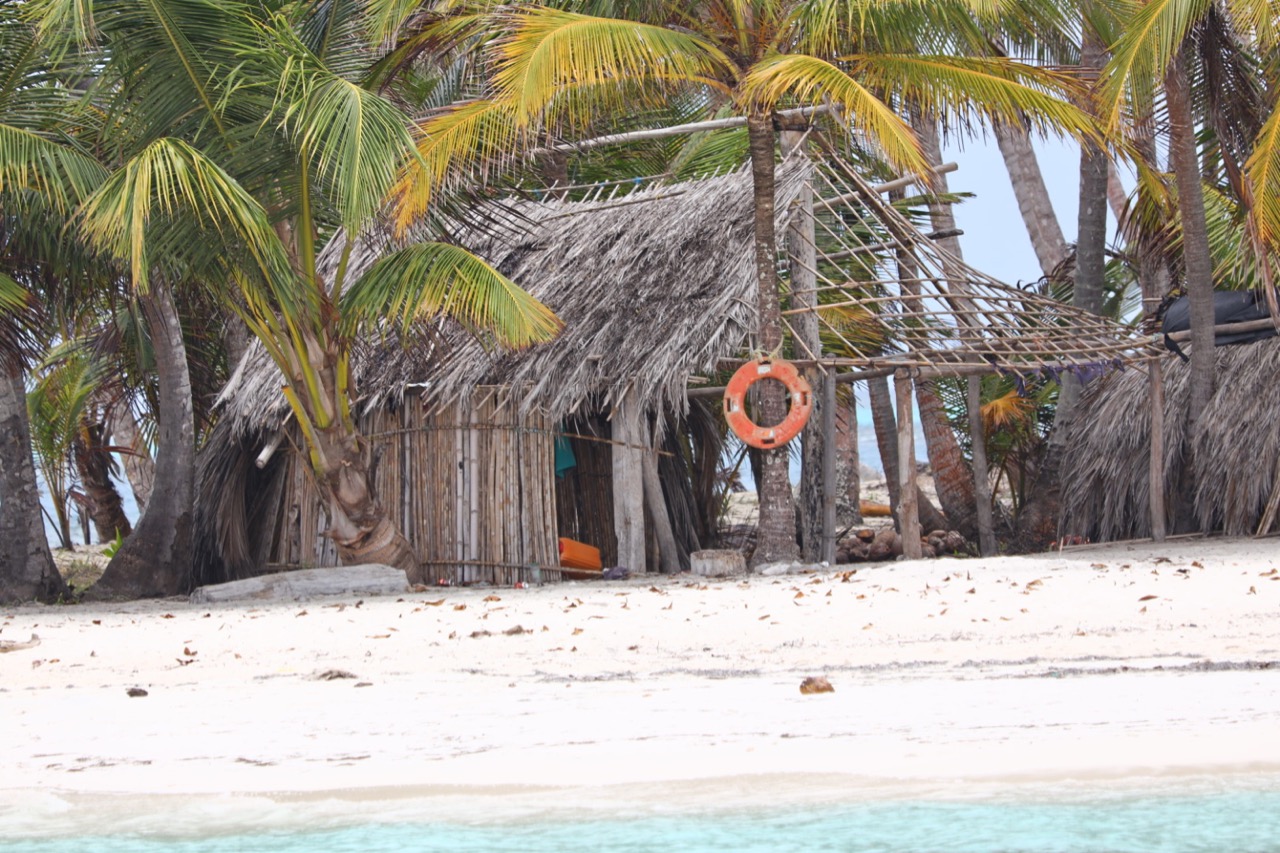
You need to buy the Panama Guide and the digital maps from Eric Bauhaus, as these are the only maps which takes you around the reef safely. Lots of stories of ship wrecked sailors, so be safe and follow the instructions.
We did all our check in for immigration and custom in Shelter Bay, including the Cruising Permit and Immigration. You can also just go there and stay for up to 72 hours or you can sail to Puerto Linton for immigration and take the bus to Portobello for the cruising permit. Both works well and depends on your agenda.
On the 30th we had arrived back to Shelter Bay and the big day for the crossing had arrived. We started the morning with Fumigation of the boat. It was Roy our agent which arranged this for 150 usd and it was done with smoke. If you do not have a certificate when you arrive in Galapagos it is done with spray and it sticks. So get it done in Panama! Then a couple of good friends and fellow sailors from Loki arrived to act as line handlers and the the big lines and fenders. By 1430 we were out in the bay, awaiting the advisor for the crossing.

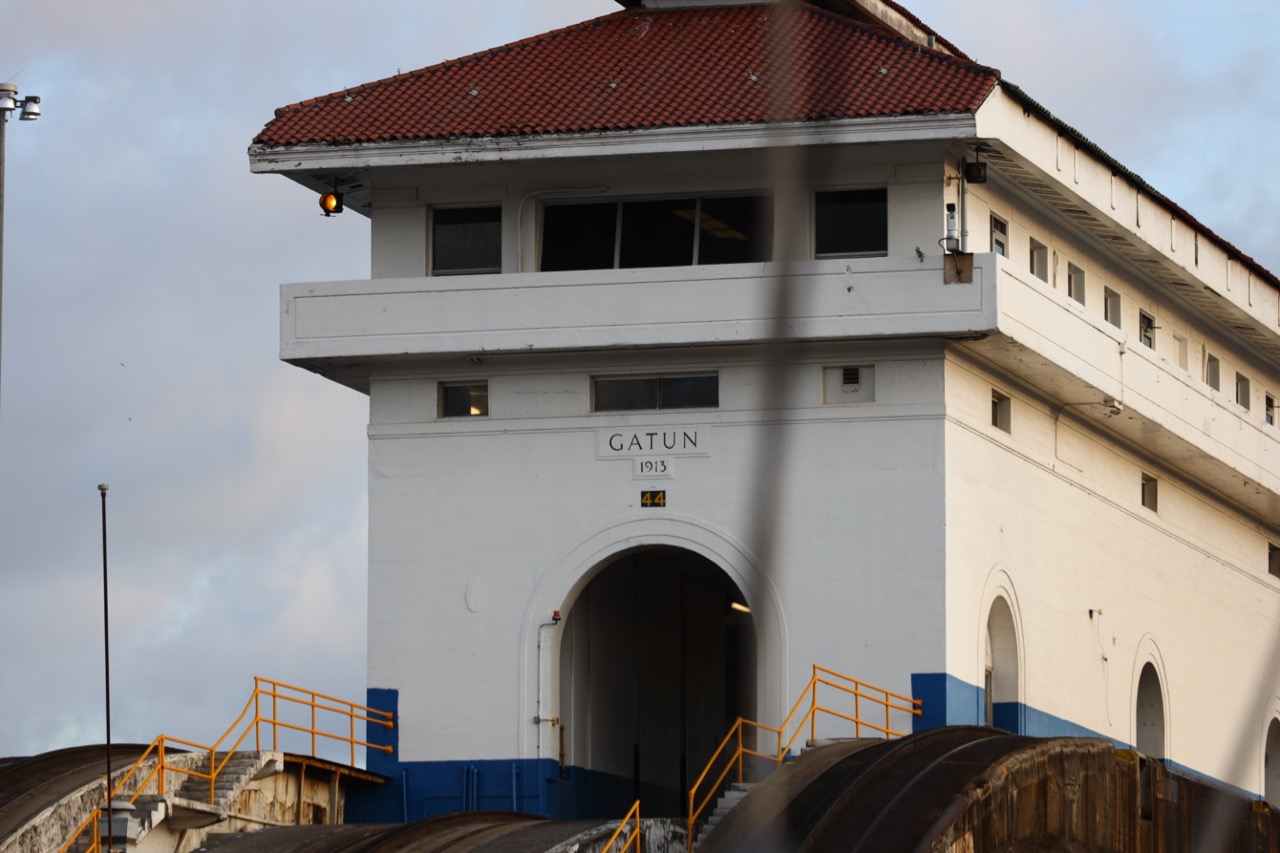
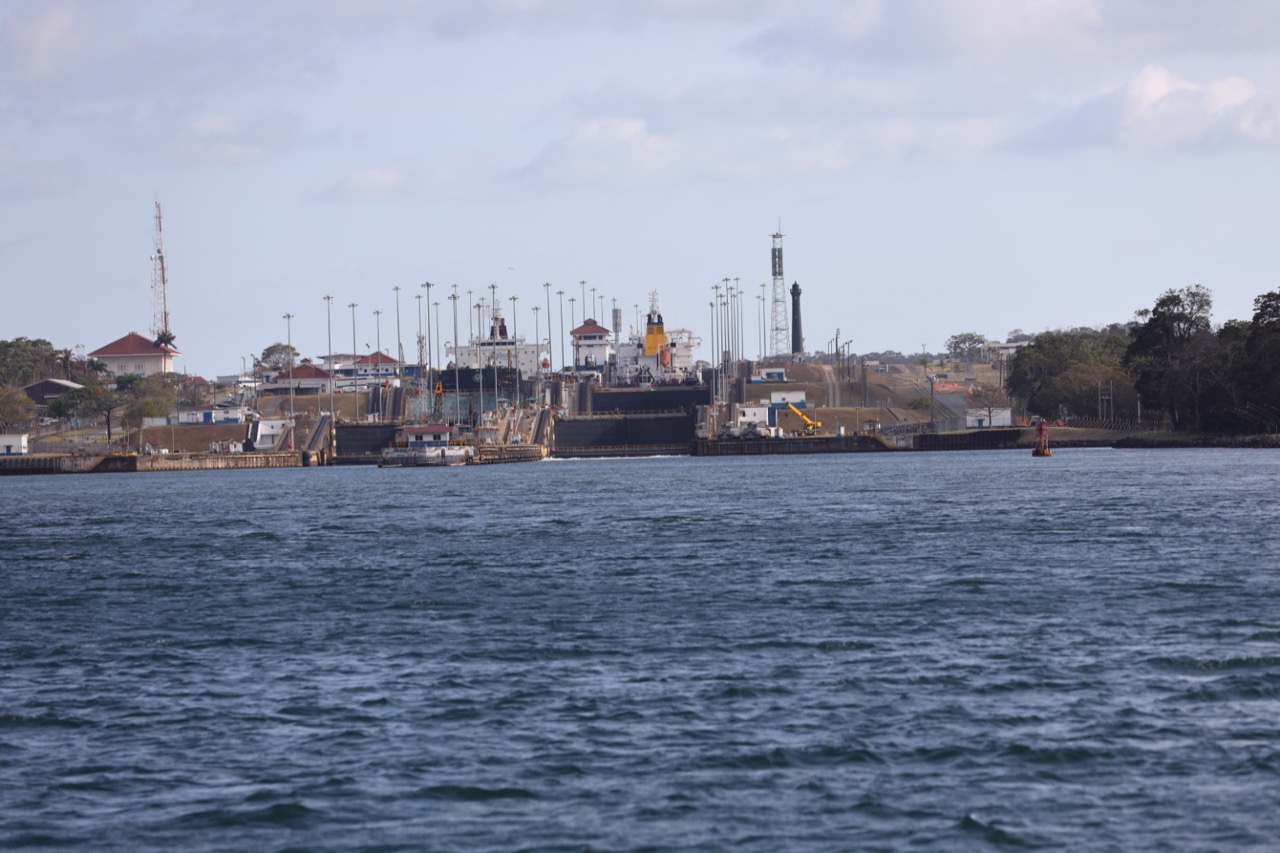


After a small delay it all went really well. The tension on the boat faded away and we realised all that it was happening. The transit from one world to another, we were crossing the line for sailors. Those who have sailed the pacific and those who have not – yes it was a really big moment. We were rafted up three boats together just befor the Gatun Lock, with a big Catamaran in the middle – a very good sailor, who took us through the locks very safely. By 2230 we were on a bouy in the man made freshwater reservoir Gatun Lake and enjoyed the sounds from the loud monkeys and watched the crocodiles – no one felt the need for a swim during the warm moonlight night.
It was impressive to go through this massive construction site, which cost a bankruptcy in France, and 22.000 peoples dead before it was finished. Finally at the beginning of the last century, the American President Roosevelt I, saw the strategic importance of the channel and made a deal with the Panamanien resistant movement against Columbia and helped them become independent. He then acquired the rights to build the channel rather inexpensive and keep it as American soil for 110 years and before actually according to the original contract to hand it over to the State of Panama a few years ago, in 1999.
The big challenges in the beginning was the big Culebra Cut before the Pacific locks, Miraflores, where the channel had to cut through massive granit hills and of course yellow fever and Malaria.
It is one of the big wonders of the world and during the last years, it has further been expanded to another set of even wider locks, so today the traffic is expanded to more than a million ships a year.

For us, to finally stand on top of North Star and look out of the last of the Miraflores chambers and see the Pacific ocean, was a fulfilment of a dream we have dreamt for a long time. Right there the real adventure started and the challenges for a cruising sailor multiplied. What a wonderful opportunity to be allowed to grasp.
Shortly we checked into La Placida Marina and prepared us for a few days sightseeing in Panama City, and the final repairs and provisioning before setting out into the big blue.
Service information:
We did buy a number of things in Flamingo Bay, where also the Flamingo Marina is. It is about ten minutes in taxi from La Placida. Chandlery and electronics were available and everything can be shipped in from US in a week. There is also a provision shop for boats, where you can but lots of speciality food we had not seen in a while. There is a market about an hour in a taxi from the marina, where you can buy eggs, veggies and fruits fresh from the farm – none refrigerated and a great shopping center and super market REYS. I would think there were 250 different shops and no shortage of variety. We ended up buying most of our stuff in Bonaire, Shelter Bay and Panama City for mostly the fresh stuff.
The long way to Panama
When we left Bonaire after 5 wonderful weeks, a visit to Copenhagen and lots of diving we were ready for more adventure, but we were cautious about that this would be our first long offshore trip, for quite a while. And there were of course also the Columbian low pressure, which were not on our side. So instead of sailing direct to Columbia, we decided to go overnight to Aruba, see the casinos and nice beaches and continue. As so often before, we realised that sailing planes are written with a pencil! We managed to find a spot for the night in Renaissance Marina, as the popular anchoring spot is just under the tam-rock of the airport, which is much less than what we were looking for.
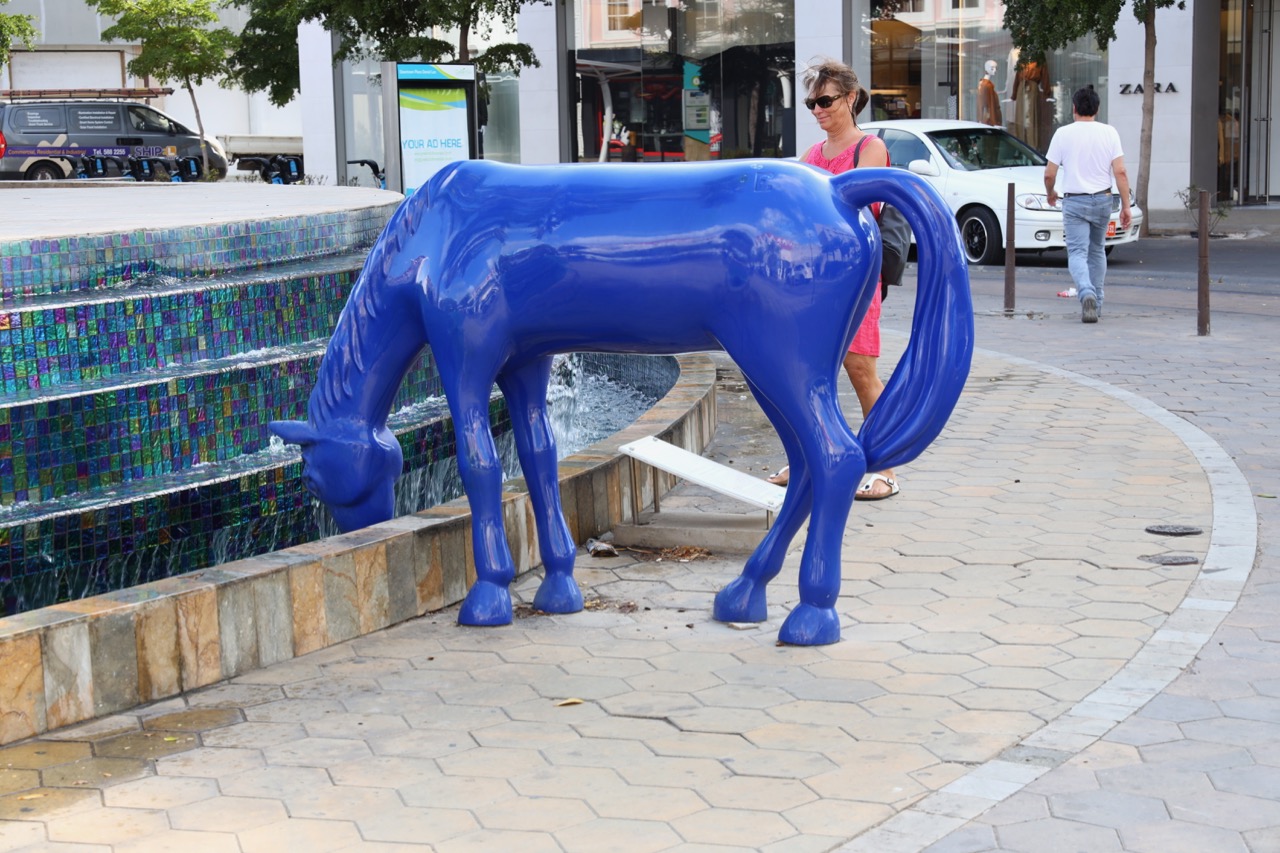


It turned out that if you were in the marina you had full access to the hotel, a great small beach island resort outside the coast, with a water taxi every 15 min and easy access to very good restaurants. And then probably more important, the low pressure system outside the Columbian coastline, which is especially strong in March and April and semi permanent forecasted 40-50 knots of wind – gale force! So we decided to use the facility and wait, which was not too bad at all. Aruba is a somewhat touristic small island, which after the oil income from Venezuela has stopped, have turned their attention to american turists and they have done that so well that 1.8 mio visitors, stay in their hotels and come in with cruise ships every year. The northern part of the island is very much marked by this and if you are looking for deserted bays and long lonely beaches, do not go. The beaches are still very nice and long, but busy. But the whole southern part is still undisturbed and locals and the island experience provided a good insight into what a non exporting small Caribbean island have done in order to survive. It was a very interesting visit and it is a comfortable place, with daily direct flights into Amsterdam.


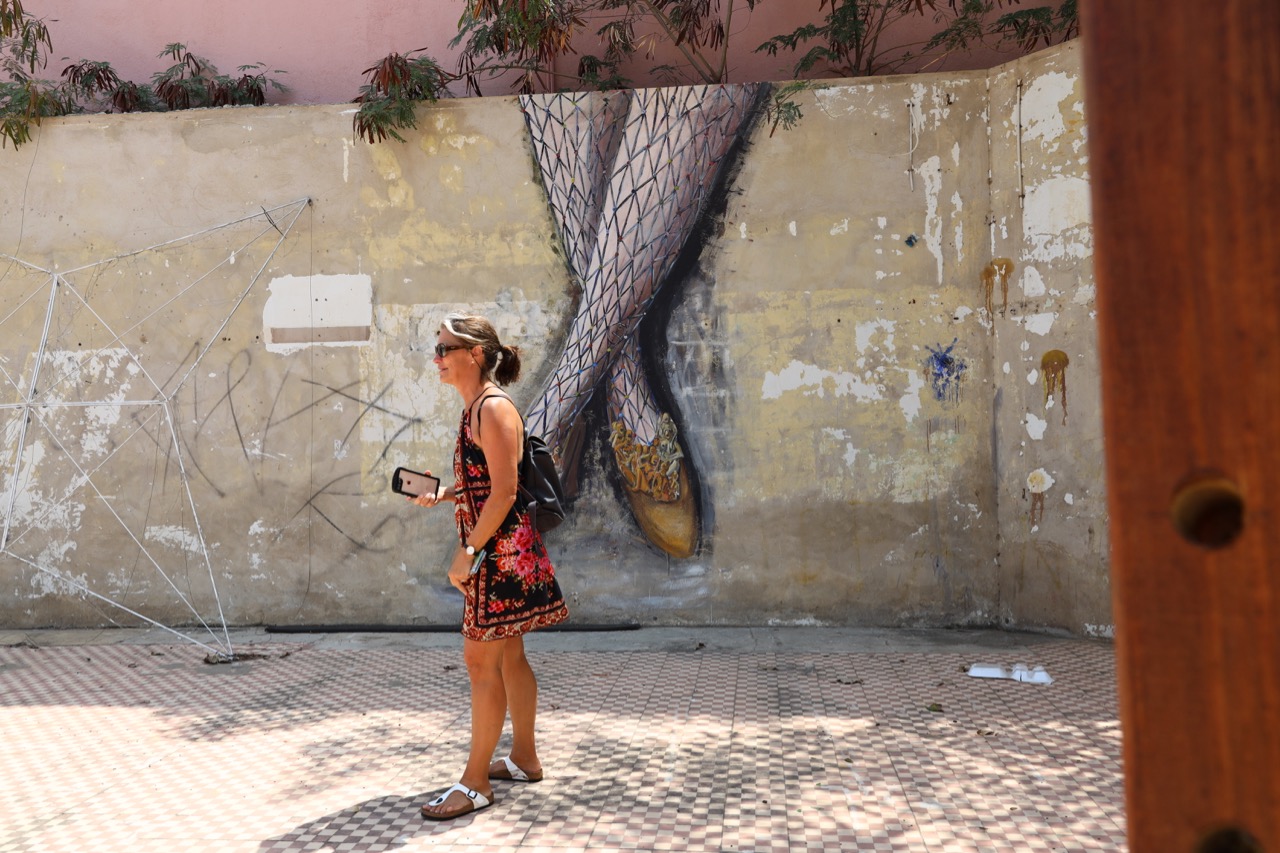
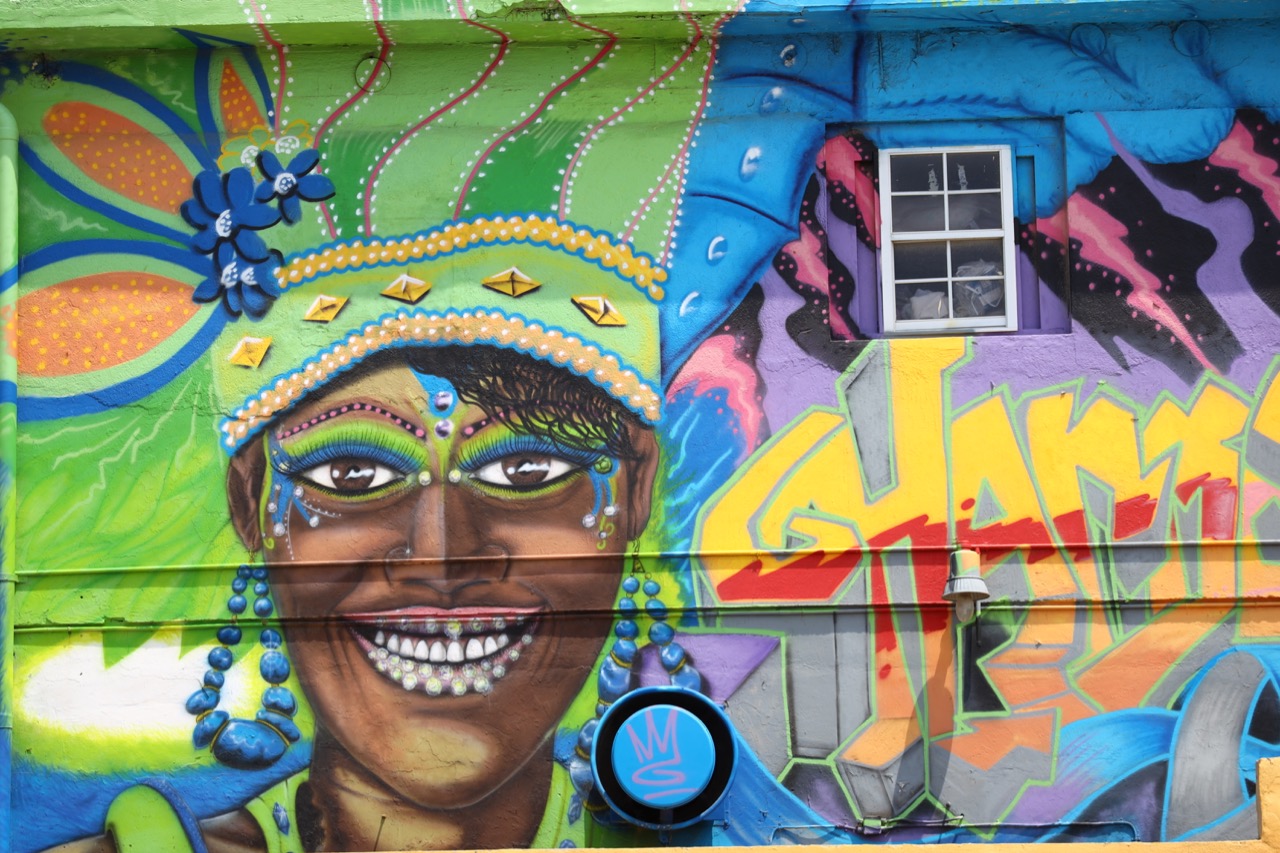
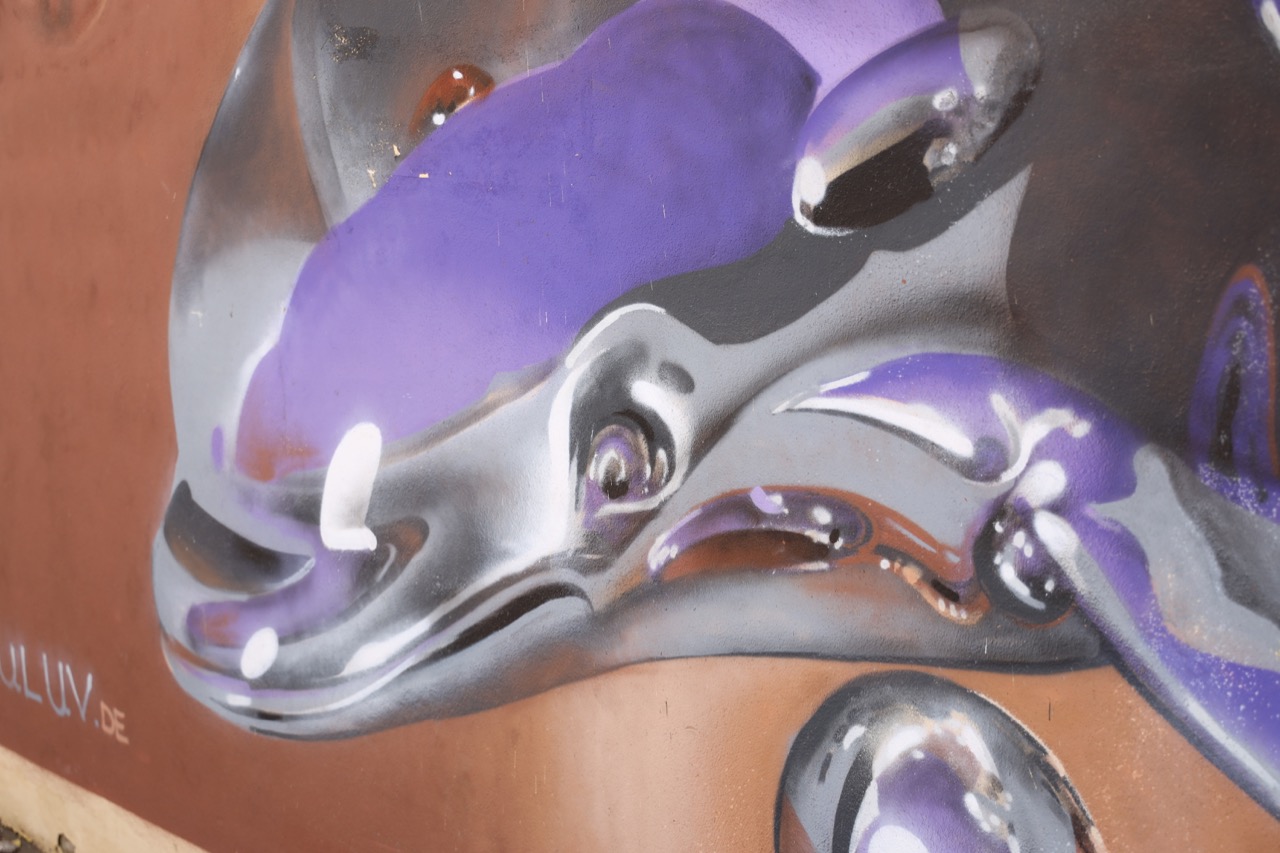
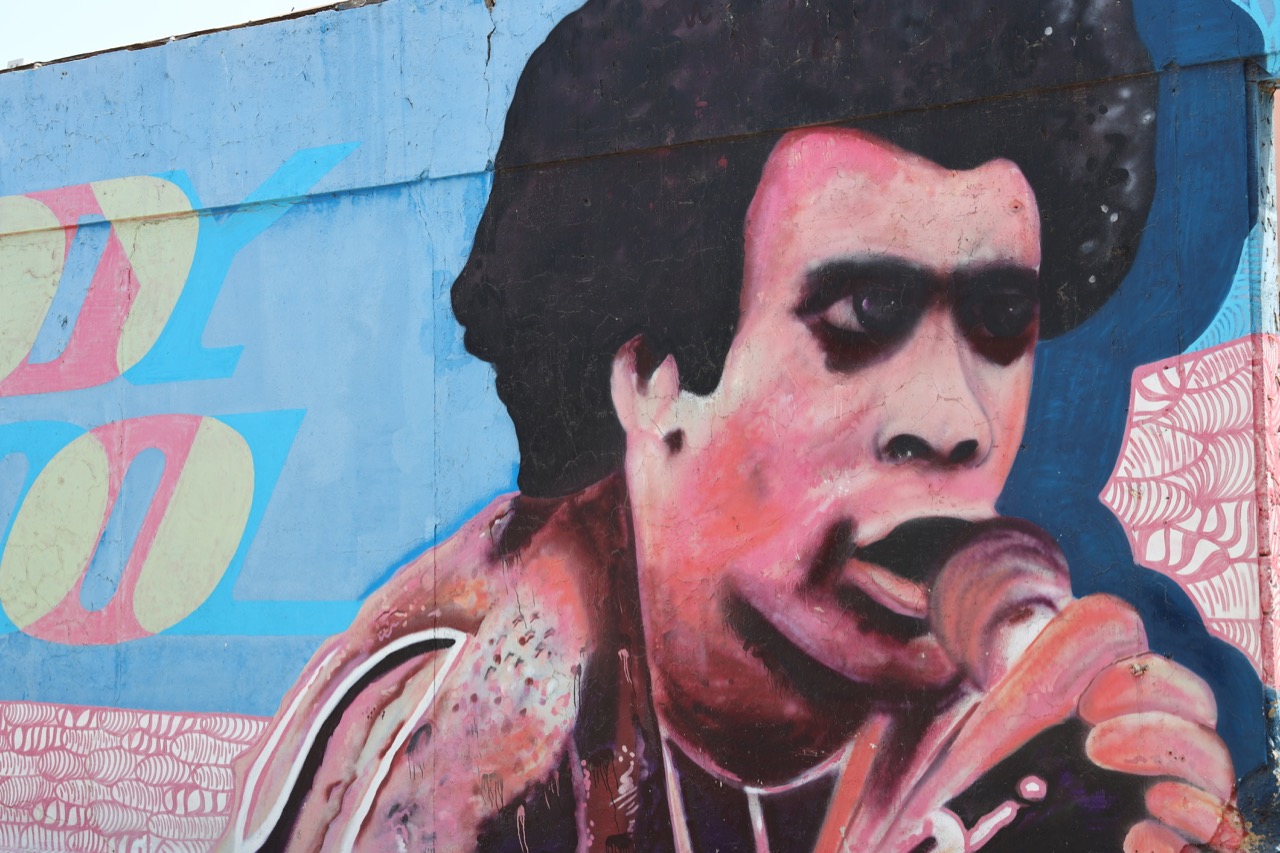
We have now visited all three Dutch Antilles islands and wow they are different from each other. Bonaire as earlier described is a very dutch local quiet diving paradise, Curazao the big city and lots of industry and finally Aruba, with all its hotels and casinos. To travel is not only about deserted islands and beaches, but also to experience and appreciate how different cultures go about living their lives in different ways.
But back to the sailing. We were waiting and waiting, as we wanted to sail along the Columbian coast to Santa Martha and Carthagena. But the low was stable and we do not go out into a full blown gale with the intention of going through it. We have tried it and we did not like it the first time and feel no need to repeat it. So here we were.
After consulting our weather mentor and meteorologist Simon Roswell from the British Sailing team, we decided to go around the blow. And this is how we ended up sailing the long way, 780 nm and 5 nights really offshore to the Panama canal instead of two small pleasant trips trips, along the Columbian coast. We sailed at the border of the gale most of the way and experienced up to 32 knots of wind and 4-5 meter waves and North Star liked it, we just got tired and agreed that if this was what our tour across the Pacific had in store for us, we better fly! Fortunate this stretch is known for exactly what we experienced and now heading into Panama in a few hours, it turned out to be a fast and god trip, where we got more experience for the future.
It is now 3 o,clock in the morning and the moon just disappeared into the ocean and left a dark ocean behind. We have been alone for 5 days except for a handfull of ships, which turned up and disappeared on radar and ais. But as we come nearer to this the busiest canal in the world, it is like sailing on the German autostrada and we are the smallest east european build Lada. The tankers are really big here in the dark! But 20 years ago it must have been scary, with todays technology it is easy to both locate and contact other ships and if you keep a close lookout and stick to the Maritime rulebook it is going well. But still the golden rule is, if you are the smallest ship do not get in the way of the bigger – they could hurt you!
Grenada to Bonaire with NO pirates
While we were waiting in Grenada, we did have a couple of wonderful weeks sailing. First we celebrated Christmas with Michaela, and enjoyed Tobago Keys, where we swam with the turtles, had lobster on the beach and watched the fantastic underwater life at the reef surrounding these small deserted atols. Following Michaelas return to civilization Marie and I had the opportunity to visit Sandy Island – a small sand strip in the ocean, with a reef around. Not as famous as Tobago Keys, but every bit as fantastic, and much more deserted.
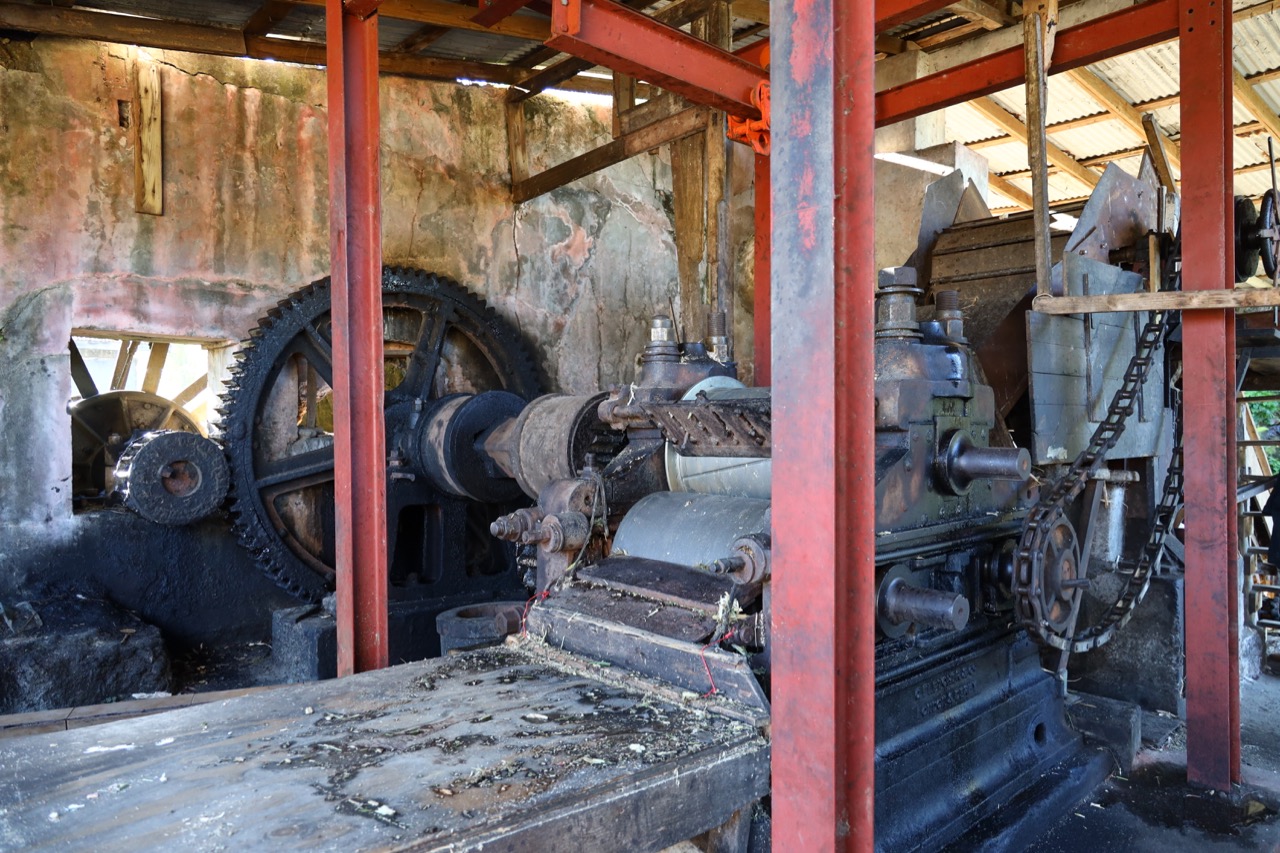
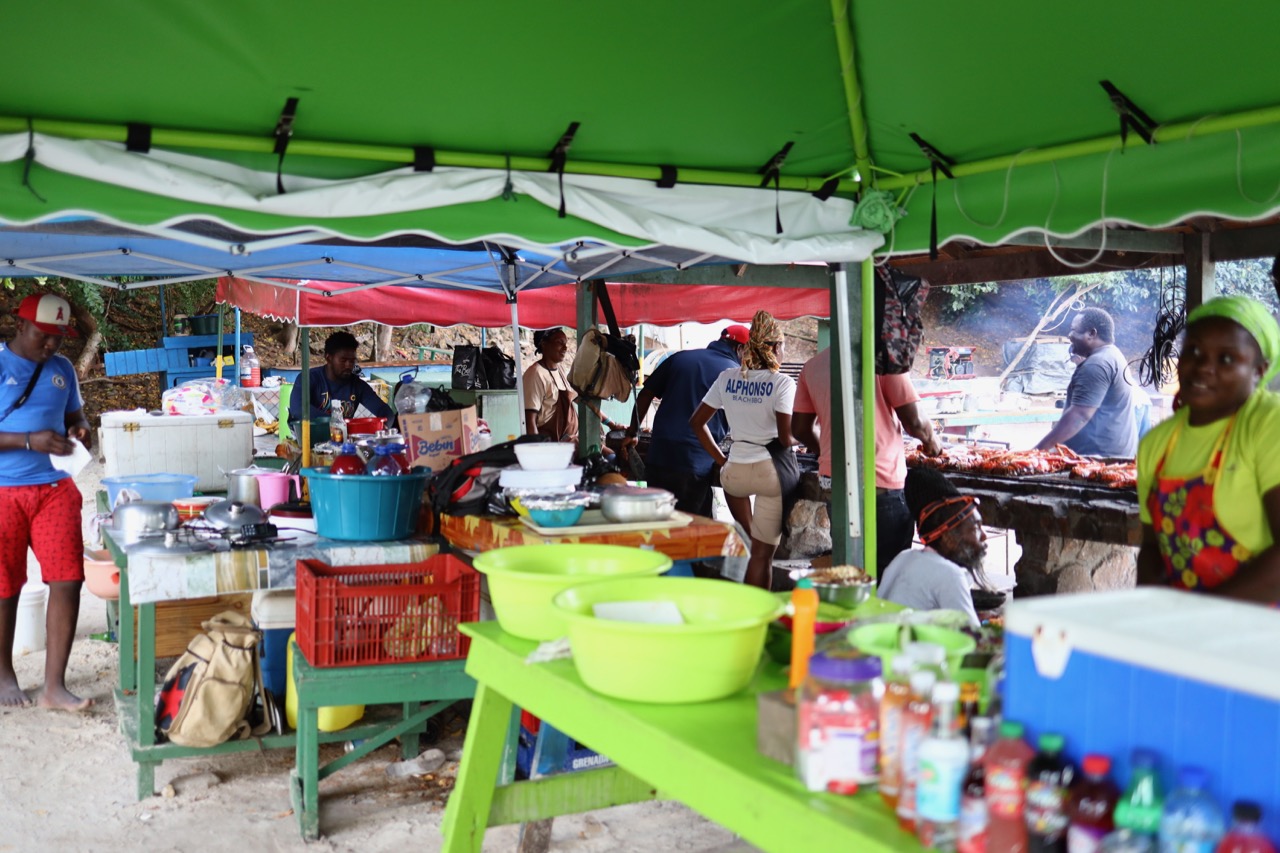
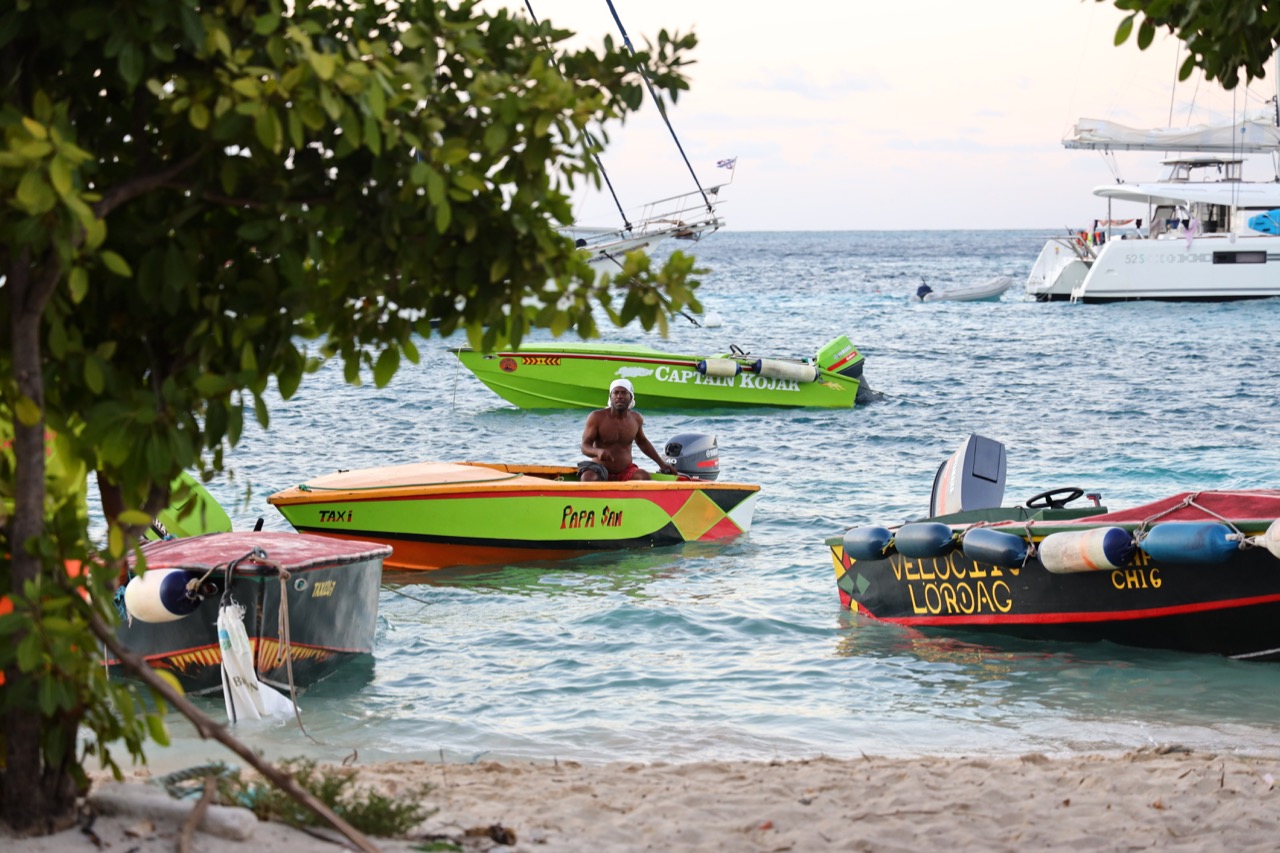
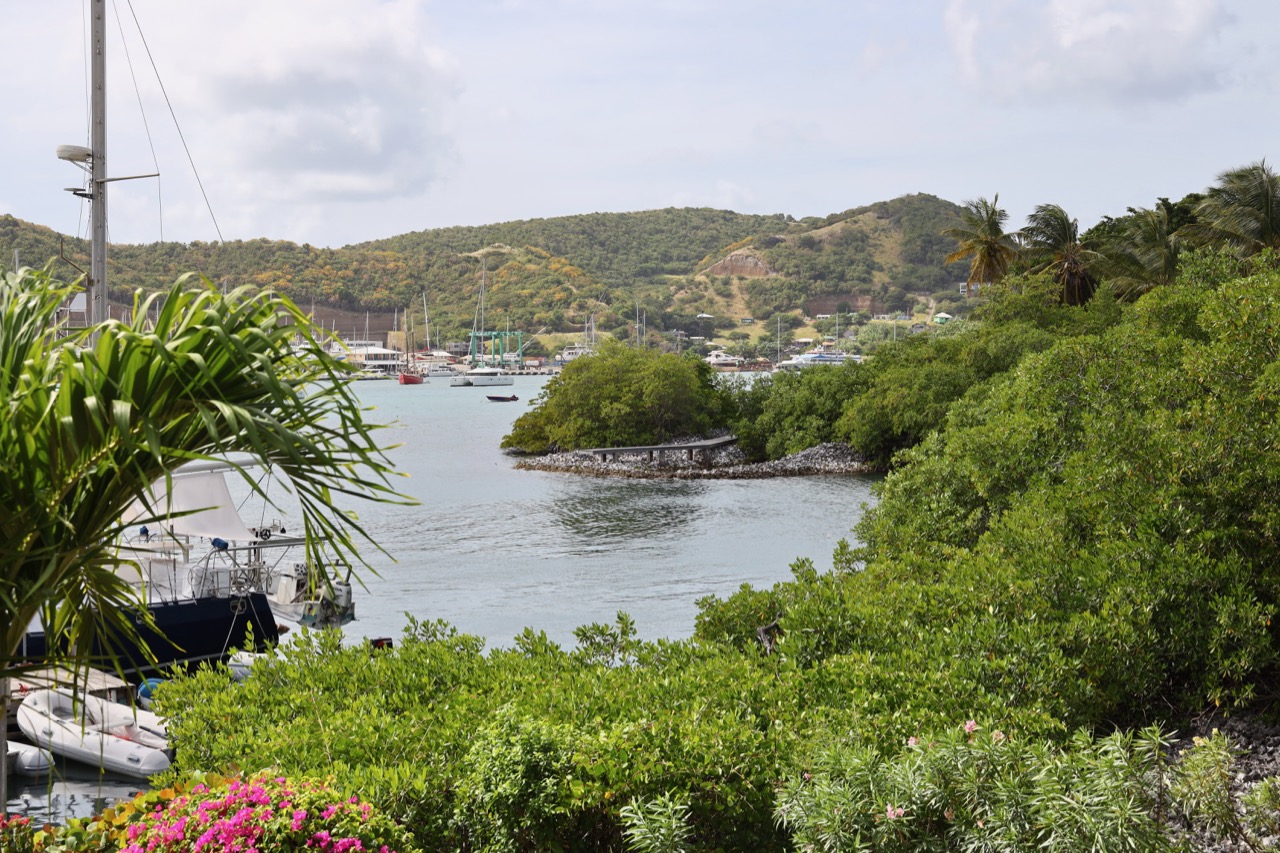
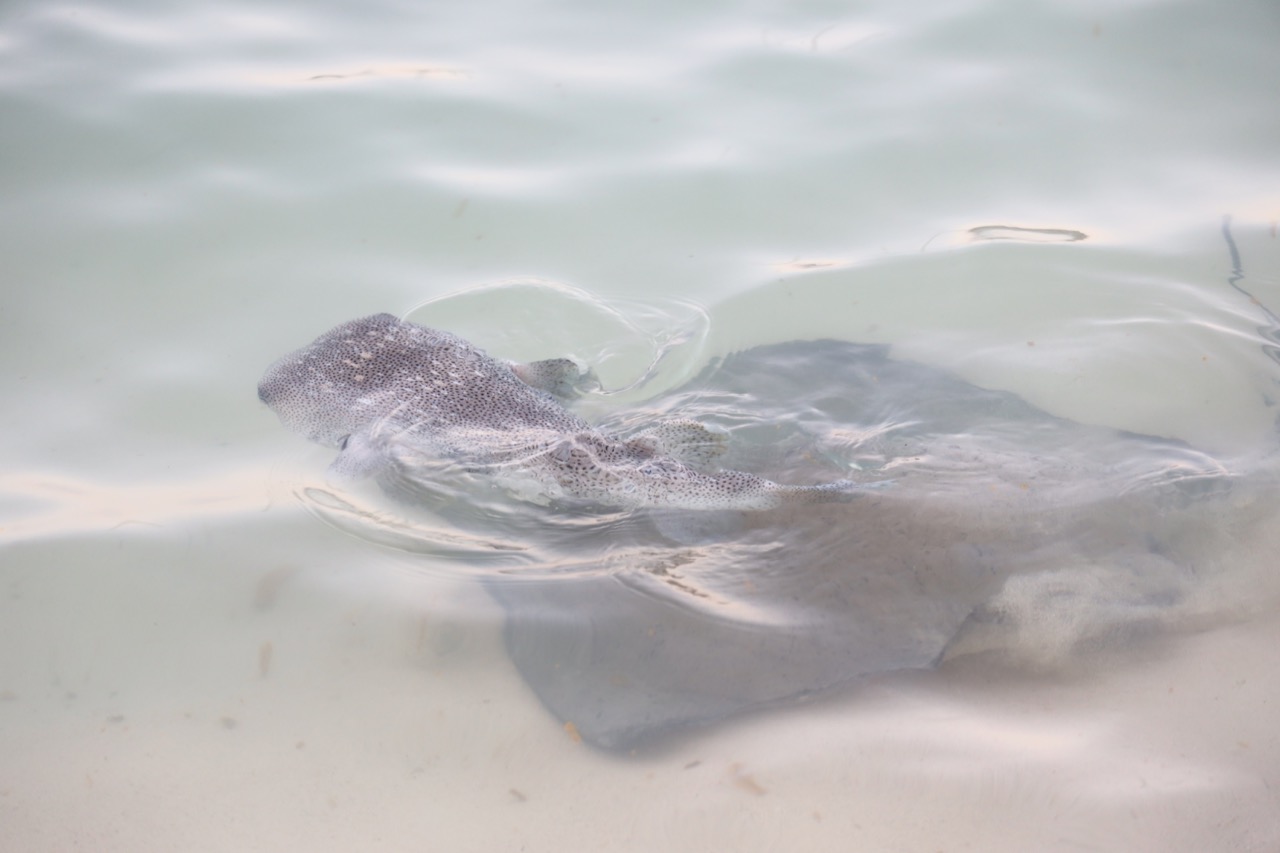
Then the day arrived and our spareparts for the water maker arrived from Norway, the technician came at the agreed time and suddenly, we were ready to depart.
Finally we left Granada with a happy boat and a very happy crew. We were engaging in a three nights and 460 nm journey from Granada to Bonaire. We were going west after an extended stay on Grenada, where all sorts of weird things happened to the boat. But the main learning was, NEVER let other people work on your boat, when you are not present
But the sailors finally got out and smelled the sea, felt the waves and got into zen with North Star. The first 24 hours or so, you are concerned. You listen and feel the boat – is all well. And then suddenly the partnership is re-established, you thrust. And being out there far from any shore, thrust in your ship, in your crew and in yourself is crucial for your ability to enjoy. I have tried both and I am sure some of you have as well! Not so great when you don’t have thrust.
It was a great sail. 15-24 knots coming in on 140 degrees, on our stern corner. We sailed a north westerly course for the first 36 hours to stay about 150 nm off the Venezuelan coast, where rumours had warned of piracy.
So when the radio suddenly came alive an hour before dark, we were a bit jumpy. “North Star this is the Venezuelan Marine”. And the call came from a cargo ship north of us in rather bad english. We discussed if we should reply, but being boarded by the Marine, and searched for narcotics is not so nice either, so we replied. It took about ten minutes and then everything were quiet and it became dark. We did not know what would happen next, and I would say, things were a little tense. But nothing happened and we turned at the southerly light tower on Bonaire around 8 am, in 25 knots after a really nice sail; where we once again re-established the thrust between Marie and I and North Star. Finally we are on our way towards the Pacific, the BIG dream after six months in the Eastern Caribbean.
Now we have been on Bonaire for a couple of weeks, diving from the beach, refreshing our skills under water in a big way. There is about 95 registered diving sites here. Many double reef experiences and a very strict protection policy of the ocean – so it is really beautiful.
Bonaire is Dutch and have been Dutch for 300 years. It is also a place where two cruise ships arrive 6 days a week which is probably both a curse and a blessing. It brings business to the island but when up to 8000 turists rampage the island from 9-5 it has a rather big impact and not all of it is nice. It is also a rather flat island, so the trade winds blow 15-25 knots everywhere and all the time.
You can buy everything here as the supermarkets are filled from Europe and US, so life is great after the Eastern Caribbean, where supply in most place where more limited. The Dutch supply similar supermarket concepts as we know from home and the Chinese supply the supermarket concept with everything else!
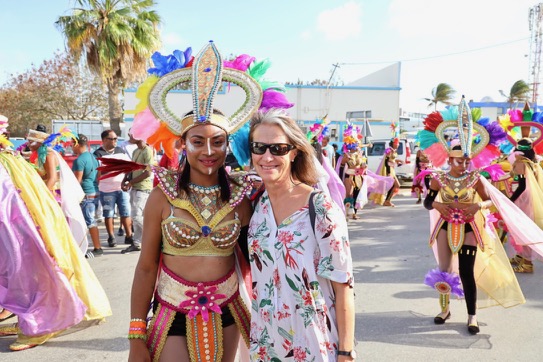
We moor in Harbour Village Marina, which is the only alternative to a moorings buoy and as Marie had to go home for a little while, thats where North Star still is. She rest between a bunch of nice American neighbours, whom either is live a-boards here in the marine or drifters of the Caribbean sea for many years.
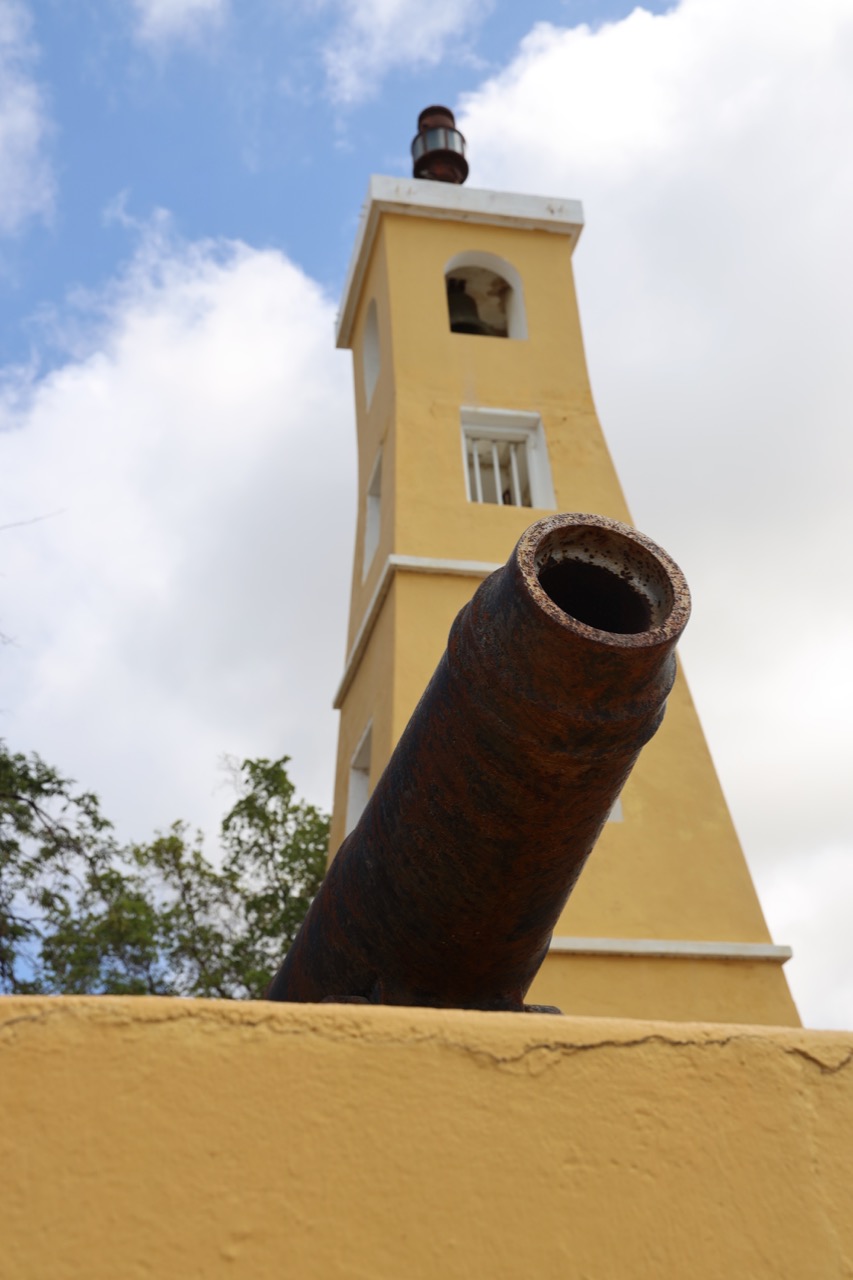
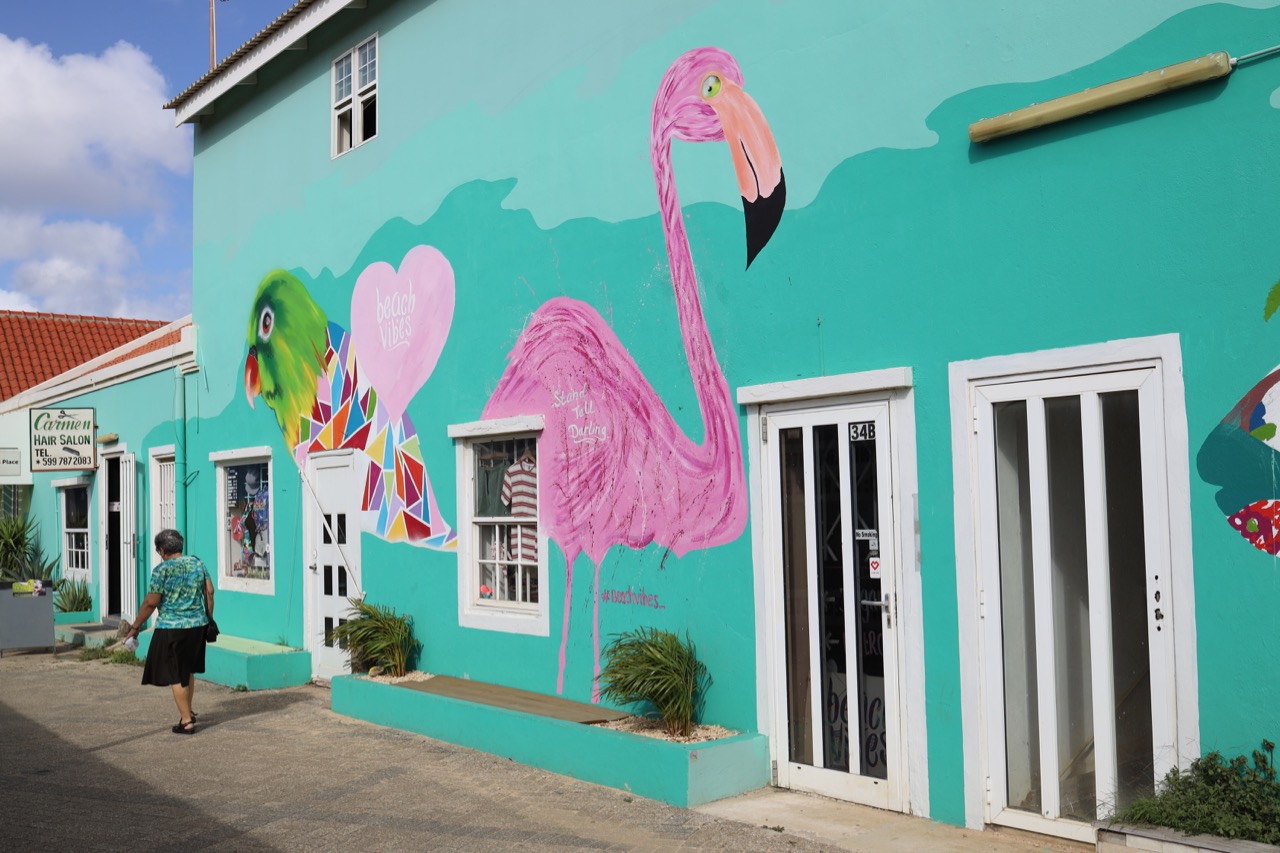
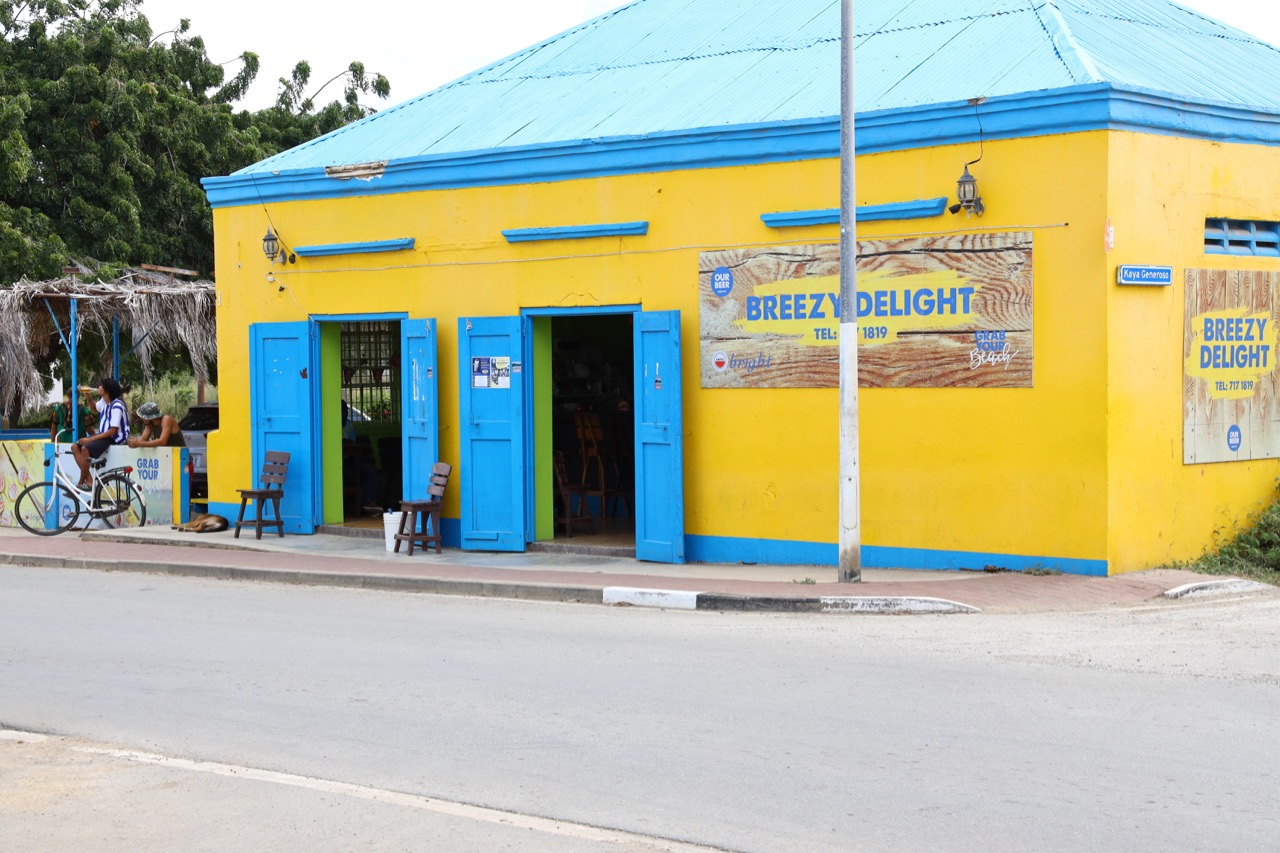
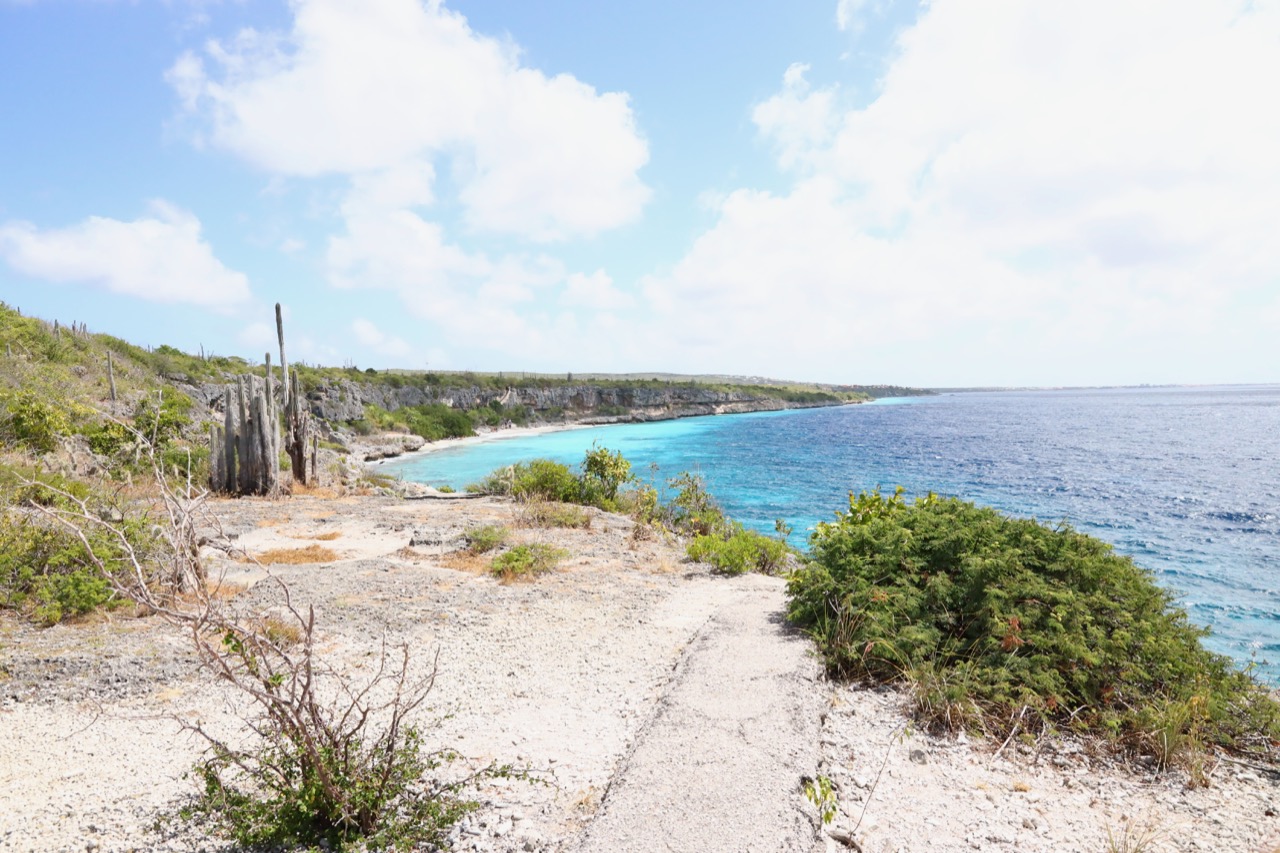
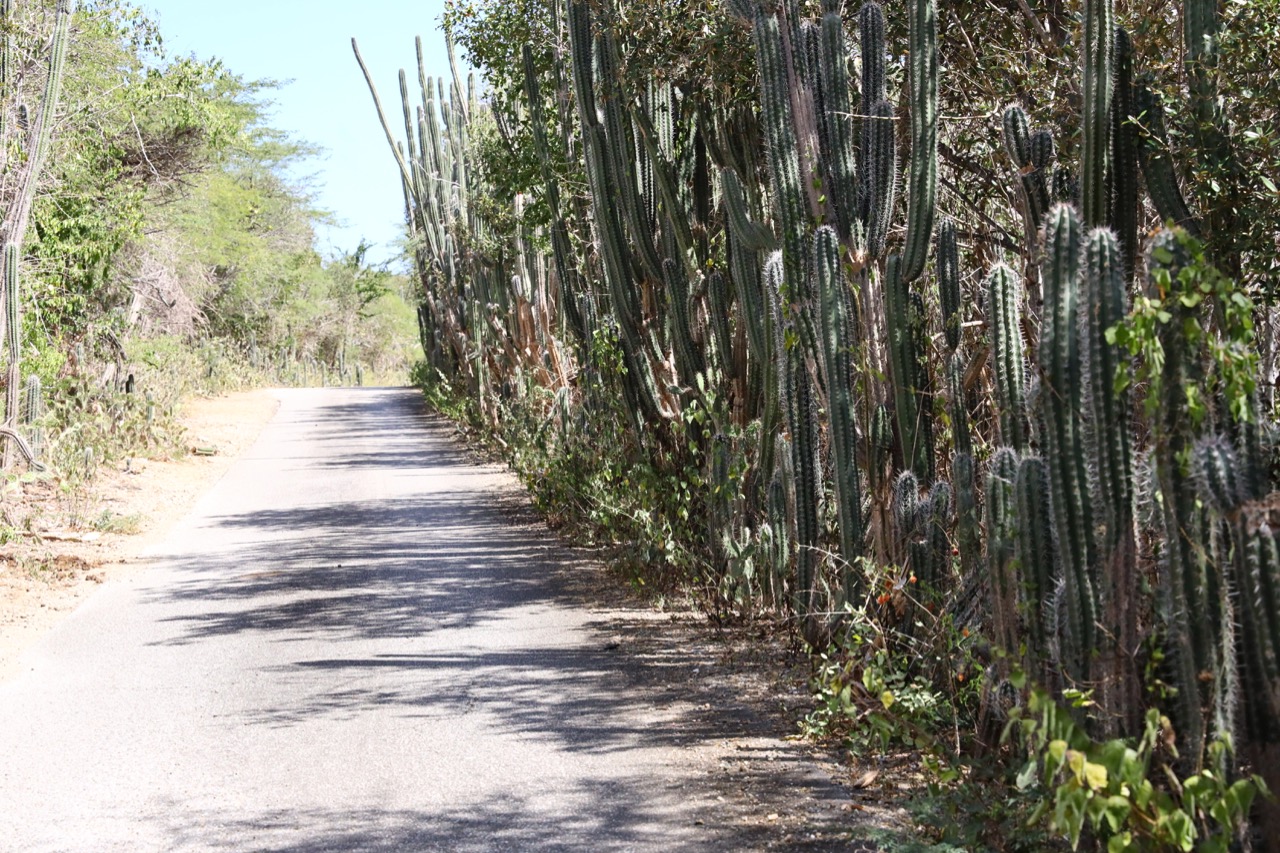
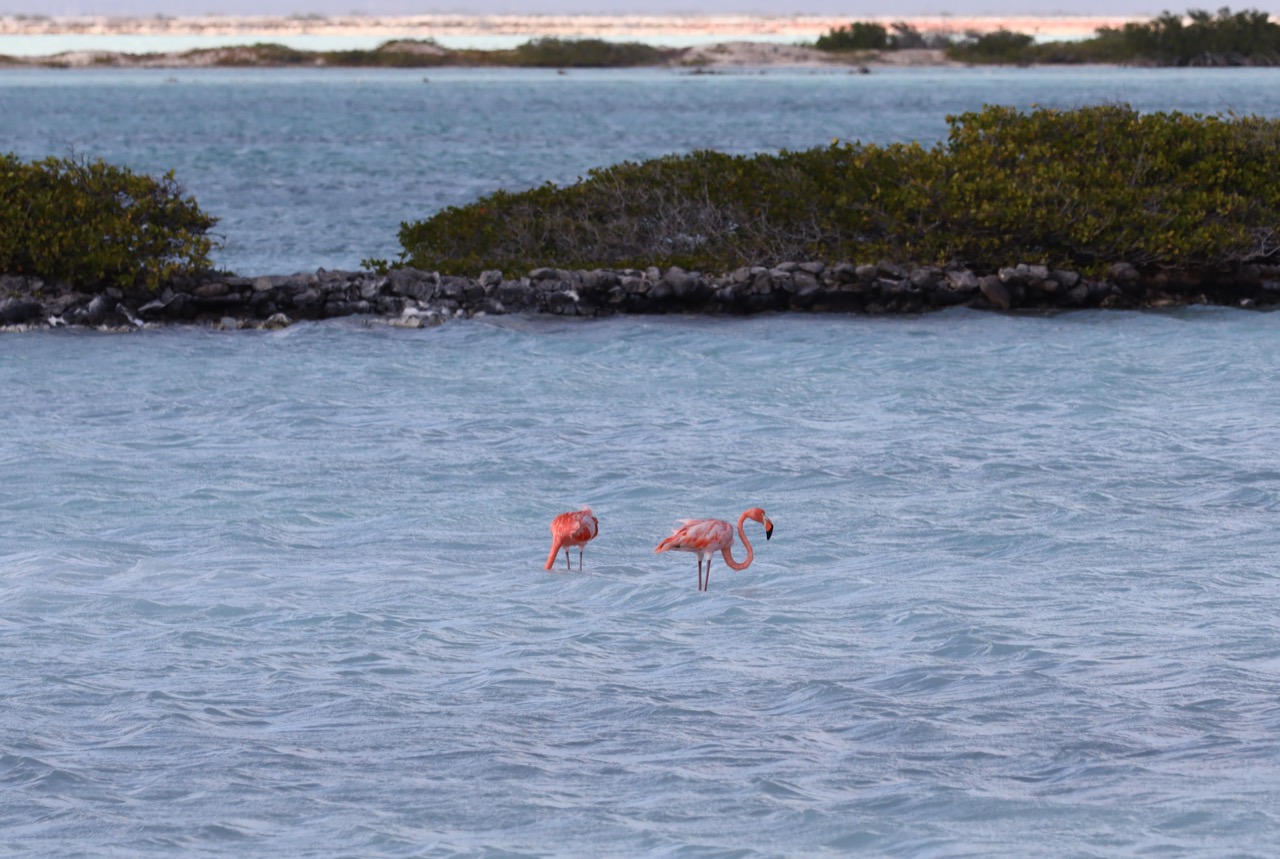
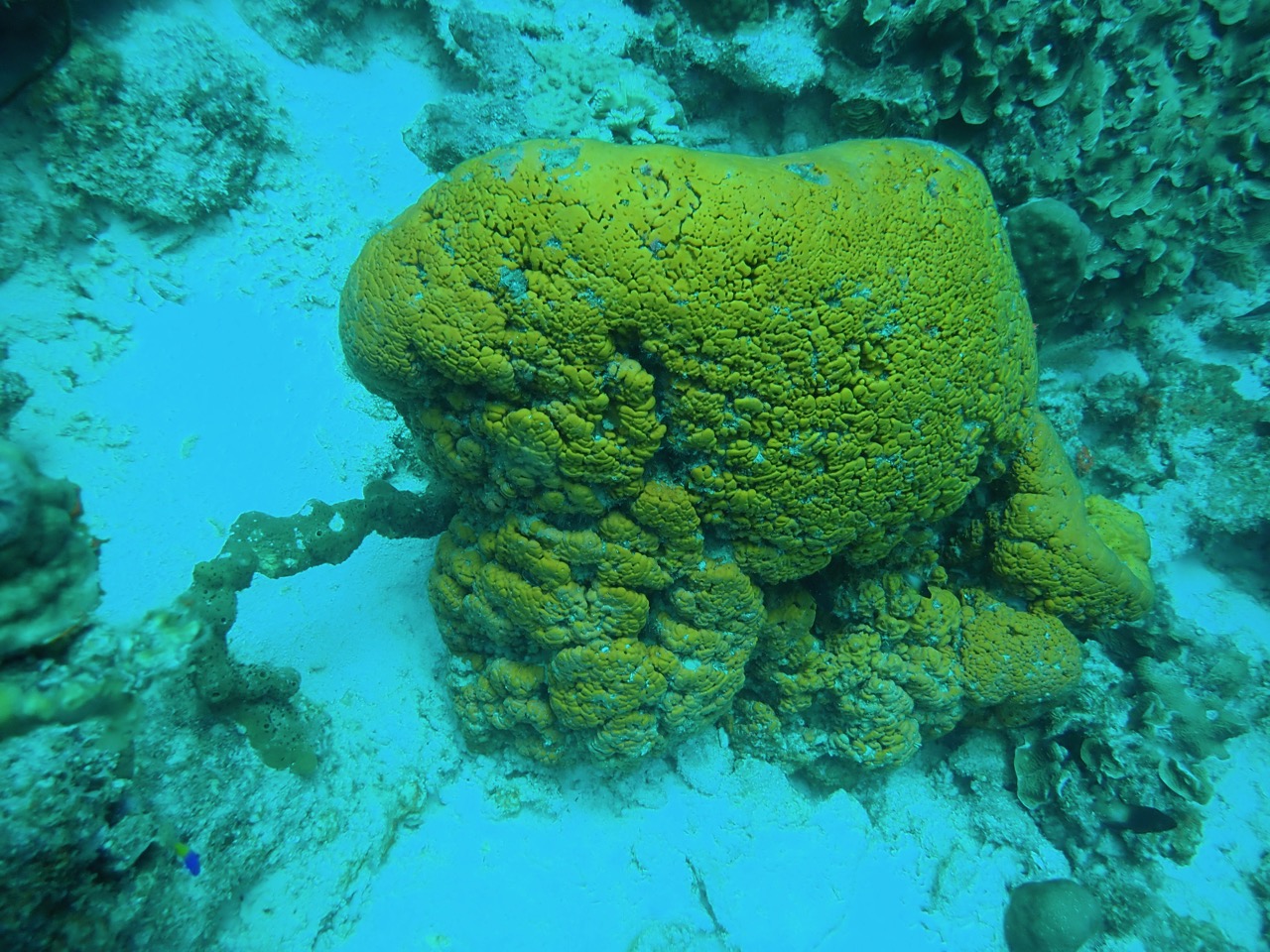
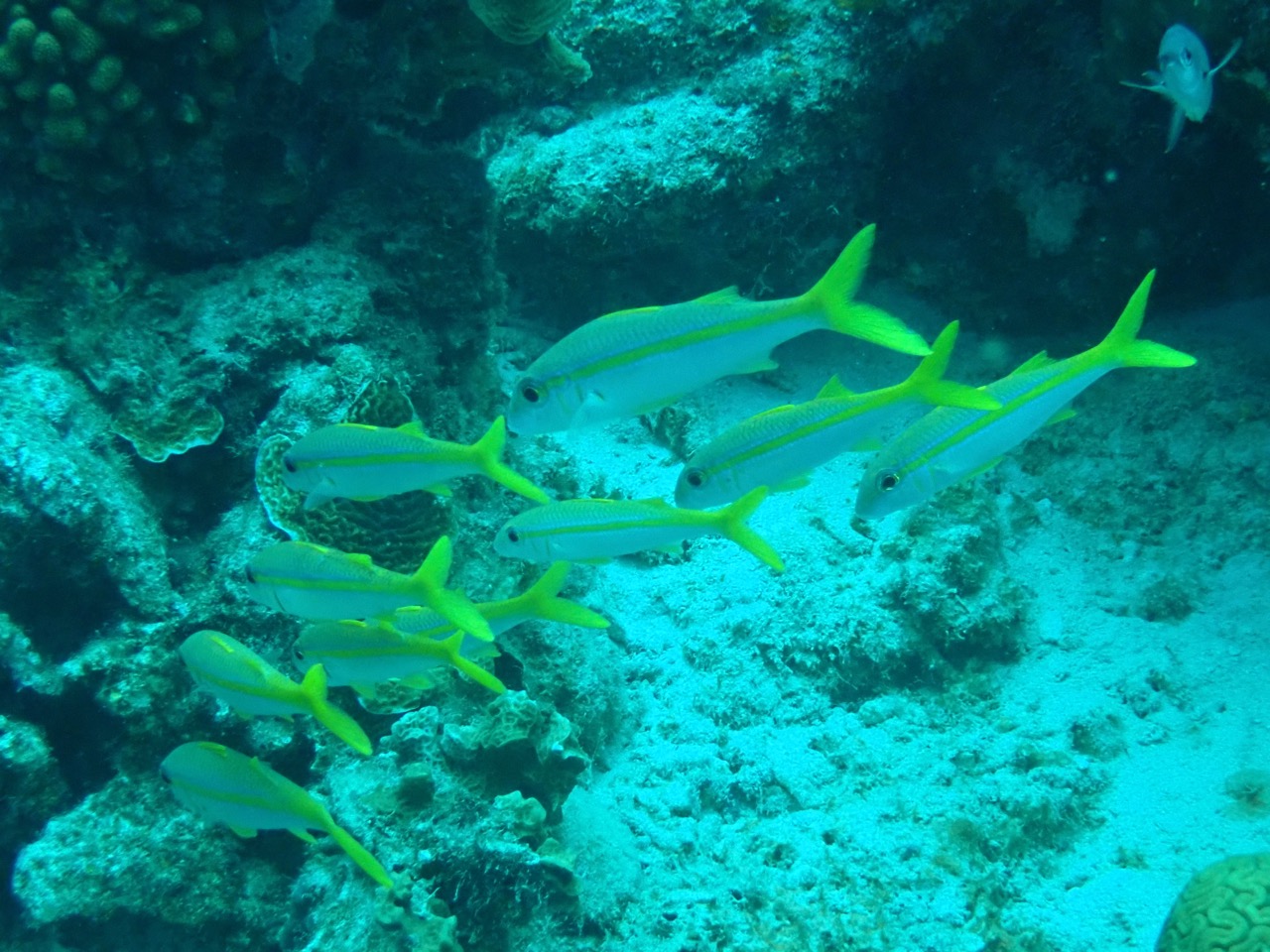
Here we dive a couple of times a day, I work on the todo list, which is always long on a sailboat and plan for the cruising of San Blas in Panama before our expedition into the Pacific Ocean.
Service information:
On Grenada we stayed in CLARKS COURT Marina and they are really good. We received lots of help from Grenada Marine, both with our Volvo engine and our water maker, also really good. We got a tremendous service from Simon the local Electrician which is at super yacht level or more. We were also impressed with Driftwood a fibreglass and woodshop in Clarks Court. We stayed in Port Louis marina and they were helpful and flexible. We had dinner and can recommend Hotel Silversand, BB crab, the local restaurant Patty’s next to Port Louis.
We can warn against Iguana Marine, who tried to fix our water maker and walked away in the middle of the job. I would think it maybe was because of lack of competence.
We learned: When you have people looking after your boat, only let them look after it. They can only work on projects onboard, when you are supervising.
